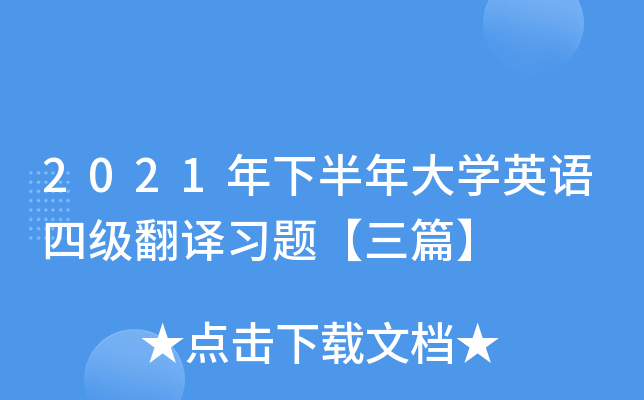
1.2021年下半年大学英语四级翻译习题
英语四级翻译练习题:年画中国人在庆祝传统新年时,有贴年画(New Year pictures)的习俗。这在宋朝的史料中有所记载。广大农村尤其流行这个习俗。在新年来临之际每个家庭都忙于往门、窗户和墙上贴彩色的年画或剪纸(paper-cut)。传统的年画是用简单清晰的线条和明亮的色彩描绘出繁荣的景象。年画表达的主题范围很广,但所有年画传递的信息一直都是好运、节日气息或人们希望的其他好事情。
参考翻译:
Chinese people have the custom of sticking up NewYear pictures to celebrate the traditional New Year.This can be traced in the historical records of theSong Dynasty. The custom is particularly popular inthe vast countryside. Upon the coming of the NewYear, every household will be busy pasting colorful New Year pictures or paper-cuts on theirdoors, windows and walls. Traditional New Year pictures are characterized by scenes ofprosperity depicted in simple, clear lines and brilliant colors. The themes expressed in NewYear pictures cover a wide range, but the messages all pictures convey are always good luck,festival atmosphere or other nice things in the wish of the people.
1.中国人在庆祝传统新年时,有贴年画的习俗:本句主语是“中国人”,可用Chinese people来表示。谓语部分是“有贴年画的习俗”,其中“有…的习俗”可译为have the customof..., “贴年画”可译为stick up New Year pictures。
2.这在宋朝的史料中有所记栽:该句可译为被动句This canbe traced in the historical records of the SongDynasty。其中谓语为be traced,“史料”可译为 historicalrecords。
3.在新年来临之际,每个家庭都忙于往门、窗户和墙上贴彩色的年画或剪纸:“在新年来临之际”可译为Uponthe coming of the New Year。“每个家庭”可译为every household。“忙于..."可译为be busy in doingsth.或be occupied with...。
2.2021年下半年大学英语四级翻译习题
英语四级翻译练习题:敦煌莫高窟敦煌是以莫髙窟(Mogao Caves)而的旅游胜地。在古代,敦煌是中国与其西方邻居之间的贸易中心。随着丝绸之路沿线贸易的蓬勃发展,敦煌迅速发展为中国历国际贸易最开放的地区。敦煌有1000多个石窟是在悬崖上雕刻出来的。石窟反映了丝绸之路的文明和历中国人民的宗教生活、艺术和习俗的重要方面,其中包括这个时期传入中国的佛教(Buddhism)。敦煌石窟一直被视为中国的国宝。
参考翻译:
Dunhuang is a renowned tourist resort famous forthe Mogao Caves.In ancient times, Dunhuang wasthe center of trade between China and its westernneighbors. With the flourishing of trade along theSilk Road, Dunhuang quickly developed to becomethe most open area in international trade in Chinese histoiy. Over 1,000 caves were cut out ofcliffs in Dunhuang. The caves reflect Silk Road civilization and important aspects of Chinesepeople's religious life, art, and customs in histoiy, including the introduction of Buddhism toChina during this period. Dunhuang grottoes have always been regarded as the nationaltreasure of China.
1.敦煌是以莫高窟而的旅游胜地:“以...而”可译为befamous for。类似短语还有be famous as(作为…而)。“旅游胜地”可译为tourist resort。
2.在古代,敦煌是中国与其西方邻居之间的贸易中心:“与...之间”可译为between,因为这句话中表示的是二者之间,而三者或三者以上之间则要用among,翻译时要注意介词的正确使用。
3.敦煌石窟一直被视为中国的国宝:其中“被视为”可译为be regarded as,也可译为be seen as或beconsidered as。“国宝”可译为national treasure。
3.2021年下半年大学英语四级翻译习题
英语四级翻译练习题:丽江古城丽江古城有800多年的历史,曾经是茶马古道(the old teahorse road)上的一个贸易集结点(confluence)。丽江因其有序的水道和桥梁系统而闻名。丽江古城在建筑、历史及其原住民纳西族(the Naxi people)的文化传统方面不同于中国其他古城。古城沿山脉和河流而建,为我们提供了一个研究古代建筑的非常珍贵的样本。独特的地理位置、历史背景以及多民族的居民,都使丽江成为最特别的古城之一。
参考翻译:
The old town of Lijiang has a history of more than800 years and was once a confluence for tradealong the old tea horse road.It is famous for itsorderly system of waterways and bridges.The oldtown of Lijiang differs from other ancient Chinesecities in architecture, history and the culture tradition of its local residents-the Naxi people.Thetown is built along mountains and rivers, providing us a very precious sample of the researchon the old-time architecture. The uniquegeographical location, historical background andmultiracial inhabitants make it one of the most special old towns.
1.丽江因其有序的水道和桥梁系统而闻名:“因...而闻名”可用be famous for...表示。
2.丽江古城在建筑、历史及其原住民纳西族的文化传统方面不同于中国其他古城:“原住民纳西族”可译为localresidents-the Naxi people。
3.古城沿山脉和河流而建,为我们提供了一个研究古代建筑的非常珍贵的样本:“沿山脉和河流”可译为along mountainsand rivers。



